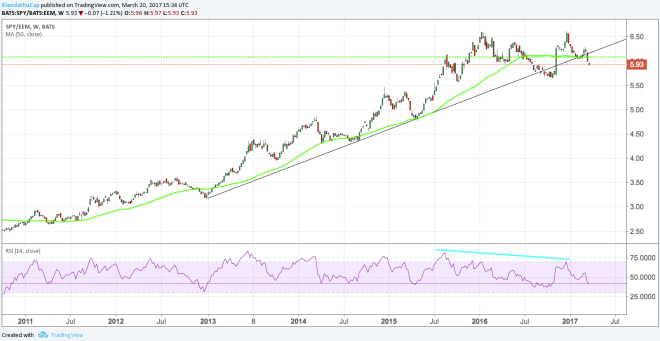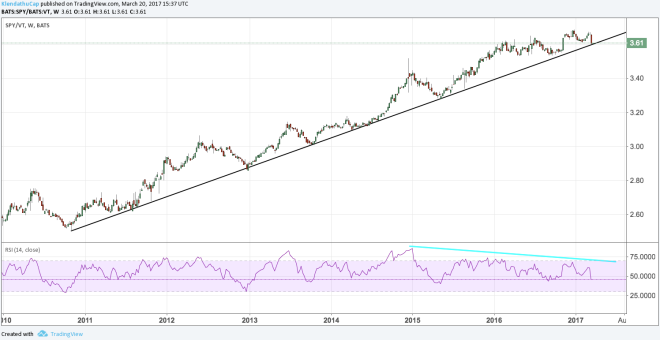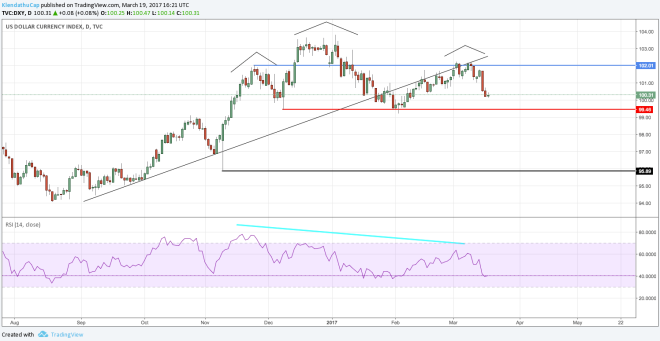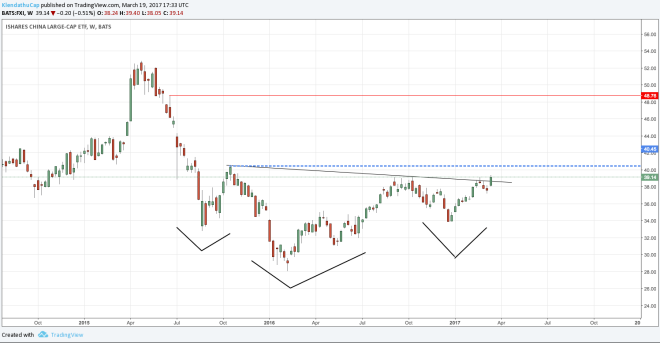The past several months I’ve been pointing out that speculators have been increasingly shifting to one side of the boat, long reflation. And then this week, central banks finally joined the party, tightening monetary policy only after these inflationary base effects had peaked.
I think this development is very bad over the medium term for global liquidity conditions. As noted by Johnathan Tepper in his recent Macrovoices interview, higher inflation and economic growth will pull excess liquidity out of financial assets and into the real economy. Throw in the hawkish shift of the world’s four largest central banks, and global liquidity conditions in the second half of the year should not be nearly as elevated as they are today.
With that said, global liquidity will not be the main topic of this week’s blog post (but I’ll touch on it later). Instead, I am choosing to focus again on yet another wobbly pillar of not just the reflation trade but US equity market’s outperformance these past +3 years as well.
In light of the hawkish shift of foreign central banks, the Fed finds that it is no longer the only game in town. Since 2013, the Fed’s relatively hawkish stance was super charged by the incredibly dovish policies that foreign central banks embarked on. During that time the ECB and BOJ increased their asset purchase programs and adopted negative interest rate policies. The combination of these central banking policies pushed capital into the US and strengthened the dollar.
As the dollar is a major source of emerging market funding, the stronger dollar tightened financial conditions in these countries, and hurt their economies which led to a prolonged period of capital outflows and equity market underperformance (vs the US). During this time, the phrase, “the cleanest shirt in the dirty hamper” was commonly applied to the US dollar, economy and stock market, but is that still true?
From a technical standpoint these trends seem to be waning and on the verge of a reversal. SPY / Europe (IEV):

Despite the parabolic move higher, US equities have gone nowhere against emerging markets for over 18 months and counting. This week, we saw a break below the 50 week moving average as well as the +3 year trendline. SPY / Emerging Markets (EEM):

SPY / World (VT):

With the central banking divergence set to converge, we could even see the Fed hold steady or shift to a more dovish policy while the ECB and BOJ further tighten monetary policy. Given that the BOJ and ECB are still experimenting with NIRP there is plenty of room for them to tighten their monetary policy. Could you imagine the rally we would see in European financials if the ECB reduced its NIRP tax on the banks?
The Fed on the other hand may have overplayed its hand. If we look at inflation where it seems everyone (except those holding record treasury short positions) is now aware of the falling base effects associated with energy prices.
But in the US, little ink has been spilt over one of the largest contributors to inflation, rental prices.
In short, the inflationary pressures that the Fed has tried to get ahead of are unlikely to develop before the June meeting. Meanwhile, economic growth is also likely to disappoint or at least not accelerate to the upside as lending growth continues to fall.
https://twitter.com/DonDraperClone/status/842855436055404544
Corporations have also put their debt issuance on hold as they wait for Trump’s regulatory cuts and stimulus package to form up.
If Trump and Congress cannot get their act together, look for the Fed to lower expectations of a future rate hikes.

Which would mean that the Fed is unlikely to defend the dollar, and we could see it fall below the 99.5 level, completing this H&S pattern that I’ve been calling for these past few weeks. More importantly, by not defending the dollar, the Fed is essentially giving the green light for capital to leave the US.

Lastly, any narrative about capital flight would not be complete without the country who has suffered from capital flight the most these past few years, China. And if there is a country that would benefit more from a falling dollar and falling US treasury yields than China I would not know it.
Previously I noted that the central authorities in China were hard at work to blow another stock bubble, Bitcoin: The Rising Tide Pressures The Biggest Leak:
“The stock market which everyone believes left for dead, may rise from its shallow grave and roar like never before. Pension funds will begin allocating additional holdings to the stock market as soon as this week. This is a pretty serious development. The last thing Beijing wants to do, is torpedo the pensions of millions of workers. On the back of this move, Chinese authorities have cut equity margin requirements from 40% to 20%.”
Just last week, the PBOC hiked interest rates. The reason: to apply more pressure on the nation’s out of control housing bubble.
It is likely that the authorities are trying to funnel China’s big ball of money back into other asset classes such as precious metals and equities. The inverse H&S pattern is quite obvious, throw in a weaker dollar and falling treasury rates and a new bull market could in fact be in the cards.

It’s worth pointing out, that being bullish Chinese equities does not mean I am necessarily bullish on China’s economy, or global growth for that matter. There’s still plenty of warning signals out there.
And as I noted earlier, the Chinese authorities are actively working to deflate their booming real estate bubble. If successful in their efforts, the deflationary effects, will reverberate across not just emerging markets but the globe. And this in my view would likely mark a great opportunity to be long the dollar. As global liquidity begins to dry up around the world approximately 3-6 months from now, the dollar should bottom and begin to build up a head of steam for all the wrong reasons, There Is No Alternative (TINA).
DISCLAIMER: This blog is the diary of a twenty something millennial who has never stepped foot inside a wall street bank. He has not taken an economic or business course since high school (for which he is immensely proud of) and has been long gold since 2012 (which he is not so proud of). In short his opinions and experiences make him uniquely unqualified to give advice. This blog post is NOT advice to buy or sell securities. He may have positions in the aforementioned trades/securities. He may change his opinion the instant the post is published. In short, what follows is pure fiction based loosely in the reality of the ever shifting narrative of the markets. These posts are meant for enjoyment and self reflection and nothing else. So ENJOY and REFLECT!

How did you learn about the markets and how to trade? Can you recommend any books? Thank you
LikeLike
I learned strategy and tactics playing video games which I have applied to financial markets and my life in general. Understanding the limits of a system, myself, and the players in it is essential to quickly learning any subject. My primary tools for studying the markets were Realvision, as well as subscriptions to Jesse Felder and Jawad Mian. I tried to learn from their mistakes while blogging/writing my way through my own mistakes.
LikeLike